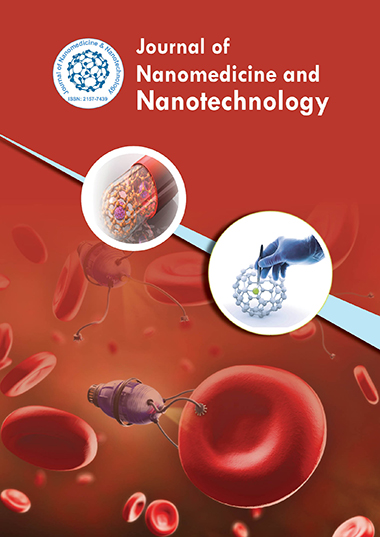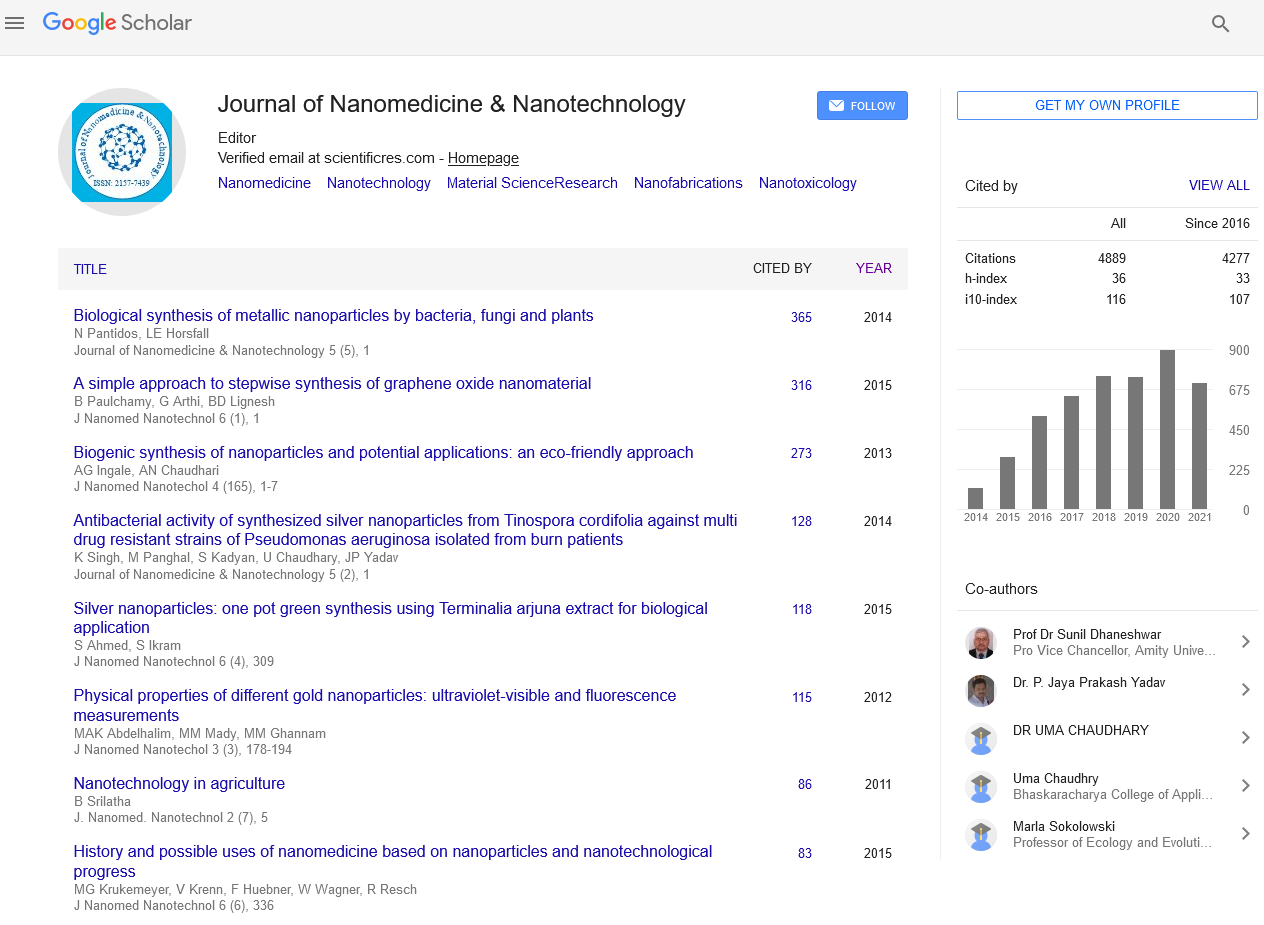Indexed In
- Open J Gate
- Genamics JournalSeek
- Academic Keys
- JournalTOCs
- ResearchBible
- China National Knowledge Infrastructure (CNKI)
- Scimago
- Ulrich's Periodicals Directory
- Electronic Journals Library
- RefSeek
- Hamdard University
- EBSCO A-Z
- OCLC- WorldCat
- SWB online catalog
- Virtual Library of Biology (vifabio)
- Publons
- MIAR
- Scientific Indexing Services (SIS)
- Euro Pub
- Google Scholar
Useful Links
Share This Page
Journal Flyer

Open Access Journals
- Agri and Aquaculture
- Biochemistry
- Bioinformatics & Systems Biology
- Business & Management
- Chemistry
- Clinical Sciences
- Engineering
- Food & Nutrition
- General Science
- Genetics & Molecular Biology
- Immunology & Microbiology
- Medical Sciences
- Neuroscience & Psychology
- Nursing & Health Care
- Pharmaceutical Sciences
Editorial - (2024) Volume 15, Issue 6
Nanoparticle-Mediated Photothermal Therapy for Tumor Ablation
Astrid Vargstrom*Received: 02-Nov-2024, Manuscript No. jnmnt-24-28226; Editor assigned: 05-Nov-2024, Pre QC No. jnmnt-24-28226 (PQ); Reviewed: 20-Nov-2024, QC No. jnmnt-24-28226; Revised: 25-Nov-2024, Manuscript No. jnmnt-24-28226 (R); Published: 30-Nov-2024, DOI: 10.35248/2157-7439.24.15.760
Abstract
Photothermal therapy (PTT) is a promising non-invasive cancer treatment modality that leverages light energy to generate heat, which can effectively ablate tumor cells. Recently, the use of nanoparticles in photothermal therapy has garnered significant attention due to their unique optical properties, such as strong light absorption and efficient conversion of light into heat. This ability allows nanoparticles to specifically target tumor sites and induce localized hyperthermia, thereby enhancing the selectivity and effectiveness of cancer treatments. Nanoparticles, including gold, carbon-based materials, and transition metal dichalcogenides (TMDs), are often employed as photothermal agents due to their ability to be functionalized for targeted delivery, as well as their excellent biocompatibility and tunable optical properties. This article explores the mechanisms, types of nanoparticles, strategies for enhancing PTT efficacy, and challenges in clinical translation, along with the future directions of nanoparticle-mediated photothermal therapy for tumor ablation.
Keywords
Photothermal therapy; Tumor ablation; Nanoparticles; Light-to-heat conversion; Cancer treatment targeting; Nanomaterials; Hyperthermia
INTRODUCTION
Cancer continues to be one of the leading causes of mortality worldwide, and while traditional treatment methods such as surgery, chemotherapy, and radiation have proven effective, they often involve significant side effects and limitations, including off-target toxicity and poor selectivity. In recent years, photothermal therapy (PTT) has emerged as a promising non-invasive cancer treatment approach that exploits the use of light to generate heat, selectively killing tumor cells while sparing healthy tissues. Photothermal therapy works by utilizing materials that absorb light, often in the near-infrared (NIR) spectrum, and convert it into heat, which then induces hyperthermia to ablate tumor cells [1]. The advent of nanotechnology has significantly enhanced the potential of PTT, as nanoparticles can be engineered to optimize their light-absorption properties, improve tissue penetration, and deliver thermal energy directly to tumor sites. Furthermore, nanoparticles can be functionalized to achieve selective targeting of cancer cells, thus minimizing systemic toxicity and improving the overall therapeutic efficacy. This review focuses on nanoparticle-mediated PTT for tumor ablation, highlighting the key materials, mechanisms, and future directions for improving this therapy [2].
NANOPARTICLES FOR PHOTOTHERMAL THERAPY
Nanoparticles are particularly suited for PTT because of their tunable optical properties, which can be optimized to absorb light in specific regions of the electromagnetic spectrum, especially the near-infrared (NIR) region. This region is particularly advantageous for biomedical applications due to its deep tissue penetration and minimal absorption by surrounding tissues. Several types of nanoparticles are currently being developed and investigated for their ability to mediate photothermal effects
Gold Nanoparticles (AuNPs)
Gold nanoparticles are among the most widely studied nanoparticles for PTT due to their exceptional biocompatibility, ease of functionalization, and tunable optical properties, particularly in the NIR region. The localized surface plasmon resonance (LSPR) of gold nanoparticles allows them to absorb light efficiently and convert it into heat. Gold nanorods (AuNRs) and gold nanoshells (AuNSs) are two common shapes of gold nanoparticles that have been extensively researched for PTT. These nanoparticles can be modified with targeting ligands such as antibodies or peptides to ensure that they accumulate specifically in tumor tissues, minimizing damage to surrounding healthy tissues [3].
Carbon-based Nanomaterials
Carbon-based materials, such as graphene oxide (GO), carbon nanotubes (CNTs), and carbon nanodots (CNDs), have also shown great promise in PTT due to their strong NIR absorption and high thermal conductivity. Graphene oxide, in particular, has emerged as a powerful candidate for photothermal therapy due to its large surface area, biocompatibility, and ease of surface modification. Carbon nanotubes, owing to their one-dimensional structure, possess high absorption efficiencies and have been explored for both photothermal and drug delivery applications.
Transition Metal Dichalcogenides (TMDs)
Two-dimensional transition metal dichalcogenides (TMDs), such as MoSâ?? and WSâ??, are a new class of materials that have shown excellent potential for PTT. These materials have strong optical absorption in the NIR region and are capable of efficiently converting light into heat. TMDs also exhibit high surface-to-volume ratios and can be functionalized with various biomolecules, making them ideal for targeted cancer therapy. Their unique properties, such as good biocompatibility and ease of integration into nanocomposite structures, position TMDs as promising candidates for tumor-specific photothermal ablation [4].
Copper-based Nanomaterials
Copper-based nanoparticles, such as copper sulfide (CuS), have also been explored for PTT applications. These nanoparticles exhibit high absorption in the NIR region and offer an attractive alternative to gold-based nanoparticles due to their low cost and ease of synthesis. Copper sulfide nanoparticles are particularly appealing because they can be designed to degrade into nontoxic products in vivo, reducing concerns about long-term toxicity.
Mechanism of Photothermal Therapy
Photothermal therapy operates through the principle of light-to-heat conversion. Upon exposure to an appropriate light source, usually in the near-infrared (NIR) region, nanoparticles absorb light energy and convert it into thermal energy. This localized heat generation leads to an increase in temperature at the tumor site, inducing hyperthermia, which has cytotoxic effects on tumor cells. The key mechanisms underlying PTT-induced tumor ablation include
Direct Thermal Ablation: High temperatures generated by the nanoparticles lead to the denaturation of proteins, disruption of cell membranes, and coagulation of tumor tissues, ultimately causing cell death [5].
Induced Apoptosis: The localized heat can trigger programmed cell death (apoptosis) in tumor cells by disrupting cellular structures such as mitochondria and inducing oxidative stress.
Vascular Collapse: The thermal energy from nanoparticles can cause the coagulation of blood vessels supplying the tumor, leading to ischemia and necrosis of tumor cells due to the lack of oxygen and nutrients.
Immune Activation: PTT can also induce an immune response, where heat-induced stress signals activate the immune system, promoting the infiltration of immune cells that help eliminate remaining cancer cells.
STRATEGIES TO ENHANCE PHOTOTHERMAL THERAPY
While nanoparticle-mediated PTT has shown great potential, several challenges need to be addressed to improve its efficacy. Several strategies are being explored to enhance PTT for tumor ablation
Surface Functionalization and Targeting
To improve the specificity of nanoparticle accumulation in tumor tissues, nanoparticles can be functionalized with targeting ligands such as antibodies, peptides, or small molecules that bind specifically to tumor-associated markers. This selective targeting minimizes off-target effects and enhances therapeutic efficacy by ensuring that nanoparticles accumulate primarily at the tumor site [6].
Combination Therapy
Combining PTT with other therapeutic modalities, such as chemotherapy, radiation therapy, or immunotherapy, has been shown to improve treatment outcomes. Nanoparticles can be designed to deliver both chemotherapeutic agents and photothermal agents simultaneously, offering a synergistic effect. The combination of PTT with immunotherapy, for example, can help activate the immune system and enhance anti-tumor responses.
Stimuli-Responsive Nanoparticles
To further enhance the effectiveness of PTT, nanoparticles can be engineered to respond to external stimuli such as pH, temperature, or light. This allows for the controlled release of therapeutic agents in response to environmental changes, improving both the safety and efficiency of PTT [7].
Multi-functional Nanoparticles
Nanoparticles can be designed to possess multiple functions, such as drug delivery, imaging, and photothermal therapy, within a single platform. This allows for real-time monitoring of treatment progress and enables more precise and personalized therapy.
CHALLENGES AND CLINICAL TRANSLATION
Despite the promising potential of nanoparticle-mediated PTT, several challenges need to be overcome before it can be widely adopted in clinical settings
Toxicity and Biocompatibility
The long-term safety and biocompatibility of nanoparticles must be thoroughly evaluated before they can be translated into clinical applications. Concerns related to the accumulation of nanoparticles in non-target organs and potential toxicity need to be addressed through careful design and optimization [8].
Efficient Light Delivery
One of the key challenges in PTT is ensuring that sufficient light is delivered to deep-seated tumors. The limited tissue penetration of light, especially in the visible and near-infrared regions, can reduce the effectiveness of PTT. Researchers are investigating new light delivery systems, including fiber optics and endoscopic techniques, to improve light penetration in deeper tissues [9].
Scalability and Cost
The scalability and cost-effectiveness of manufacturing nanoparticles for PTT remain significant obstacles to their widespread clinical application. The development of cost-efficient, scalable production techniques is necessary for the commercial success of nanoparticle-based PTT [10].
CONCLUSION
Nanoparticle-mediated photothermal therapy is a highly promising approach for tumor ablation, offering a minimally invasive, targeted, and effective treatment option for cancer patients. By leveraging the unique optical properties of nanoparticles and their ability to be functionalized for selective targeting, PTT can significantly improve treatment outcomes. Continued research into the optimization of nanoparticle design, combination therapies, and clinical translation will pave the way for more effective and personalized cancer treatments in the near future.
REFERENCES
- Qin B, Pei J, Guo H, Dong X, Zong B, Li D. Bioinspired nanoparticles for direct intratumoral chemotherapy of local cancer. J Mater Chem B. 2019; 7(23): 3646-3652.
- Shi Y, van Steenbergen M J, Teunissen A J P, van der Meel R, Lammers T. Drug delivery strategies for platinum-based anticancer drugs. Expert Opin Drug Deliv. 2020; 17(5): 587-604.
- Ma D, Zhang, H B, Shu W. Integration of a Nanocarrier-Based Platform for Dual-Responsive Cocktail Chemotherapy and Dual-Modal Imaging. Advanced Materials. 2019; 31(12): 1807887.
- Hobbs S K, Monsky, W L, Yuan F, Roberts W G, Griffith L, et al. Regulation of transport pathways in tumor vessels: Role of tumor type and microenvironment. Proc Natl Acad Sci. 2018; 95(8): 4607-4612.
- Dong Y, Love K T, Dorkin J R, Sirirungruang S, Zhang Y, Chen D, Â et al. Lipopeptide nanoparticles for potent and selective siRNA delivery in rodents and nonhuman primates. Proc Natl Acad Sci. 2018; 111(11): 3955-3960.
- Li Y, Wang Y, Huang G, Gao J, Cooper I R, Ji J, et al. Recent progress in smart drug delivery nanosystems using stimuli-responsive polymers. J Mater Chem B. 2019; 7(8): 1139-1161.
- Miao L, Huang L, Exploring N. Nano-enabled delivery of RNAi and CRISPR-Cas9 for cancer treatment. Nano Today. 2020; 32: 100853.
- Wang Z, Li X, Ying Z. Combining Magnetic Nanoparticles and Ultrasound for Drug Delivery in Cancer: A Comprehensive Review. Crit Rev Oncol Hematol. 2018; 131: 34-49.
- Lentacker I, Geers B, Demeester J. De Smedt, S. C. Advanced Delivery Strategies for Anticancer Nanomedicine. Nanomedicine. 2021; 7(2): 179-196.
- Kieran D, Woods A, Villalta-Cerdas A, Weiner S. Tumor-associated antigens for the induction of antitumor immune responses. Annual Review of Immunology. 2020; 39: 251-272.
Indexed at, Google Scholar, Crossref
Indexed at, Google Scholar, Crossref
Indexed at, Google Scholar, Crossref
Indexed at, Google Scholar, Crossref
Indexed at, Google Scholar, Crossref
Indexed at, Google Scholar, Crossref
Indexed at, Google Scholar, Crossref
Indexed at, Google Scholar, Crossref
Citation: Astrid V (2024) Nanoparticle-Mediated Photothermal Therapy for Tumor Ablation. J Nanomed Nanotech. 15: 760.
Copyright: ©2024 Astrid V. This is an open-access article distributed under the terms of the Creative Commons Attribution License, which permits unrestricted use, distribution, and reproduction in any medium, provided the original author and source are credited.


